
Full resolution (JPEG) - On this page / på denna sida - Topography, by Andr. M. Hansen

<< prev. page << föreg. sida << >> nästa sida >> next page >>
Below is the raw OCR text
from the above scanned image.
Do you see an error? Proofread the page now!
Här nedan syns maskintolkade texten från faksimilbilden ovan.
Ser du något fel? Korrekturläs sidan nu!
This page has been proofread at least once.
(diff)
(history)
Denna sida har korrekturlästs minst en gång.
(skillnad)
(historik)
TOPOGRAPHY
It is quite superficially that the Scandinavian peninsula is
separated from the continent by the shallow basin of the Baltic.
In reality it is the same uniformly built, even plateau of gneiss
and granite, with a few remains of palæozoic strata, that is continued
from Finland, just dips beneath the level of the Gulf of Bothnia,
and then rises again slowly towards the west to an altitude of
about 1500 feet. Approaching the Atlantic, however, the rocky
ground suddenly changes, and the landscape acquires another
character. Above the low Baltic plateau, a new plateau rises with
a clearly defined step almost in a line from Lindesnes to the
North Cape, about 100 miles within the western coast. This higher
plateau arches slightly, to a height of about 3000 feet, from the
eastern edge towards the crest of the peninsula, which runs NNE,
whence again the western side dips down with a slight curve into
the Atlantic. Geologically, it appears that a new flake of the
earth’s crust has been reached here, of which part of the edge
appears to be pushed far out over the Baltic plateau, with
greatly transformed crystalline schists. Farthest west along the
coast, there are lines of eruptive rocks, granite and gabbro,
between archaic strata, highly folded, with their strike following
the coast-line. We here evidently have remains of old coast-chains
along the fall of the continent towards the ocean, as it is in so
many places, e. g. the Cordilleras. Whatever there have once
been, however, of actual mountain-chains have become levelled in
the course of long geological periods; we have nothing left but
a fairly level surface, afterwards forced up along the west margin
of the peninsula, like a low barrel vault, about 100 miles in width,
<< prev. page << föreg. sida << >> nästa sida >> next page >>